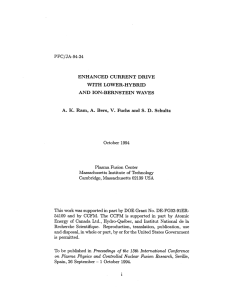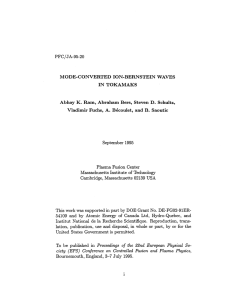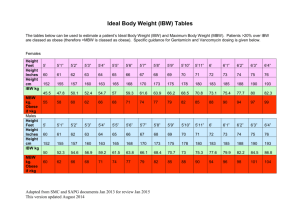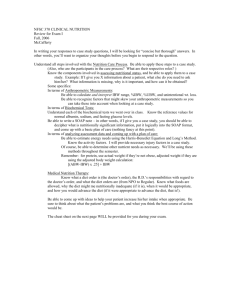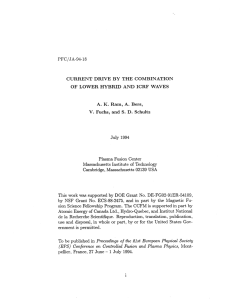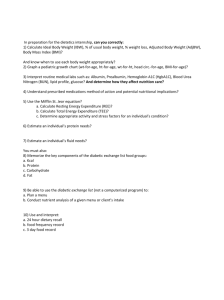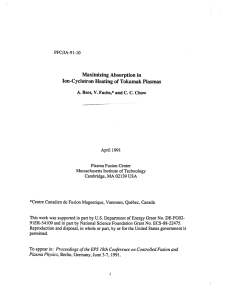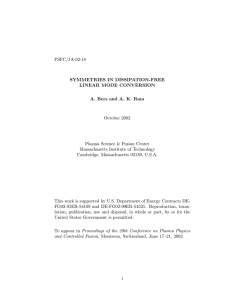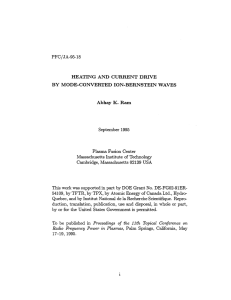in lower-hybrid current drive
advertisement
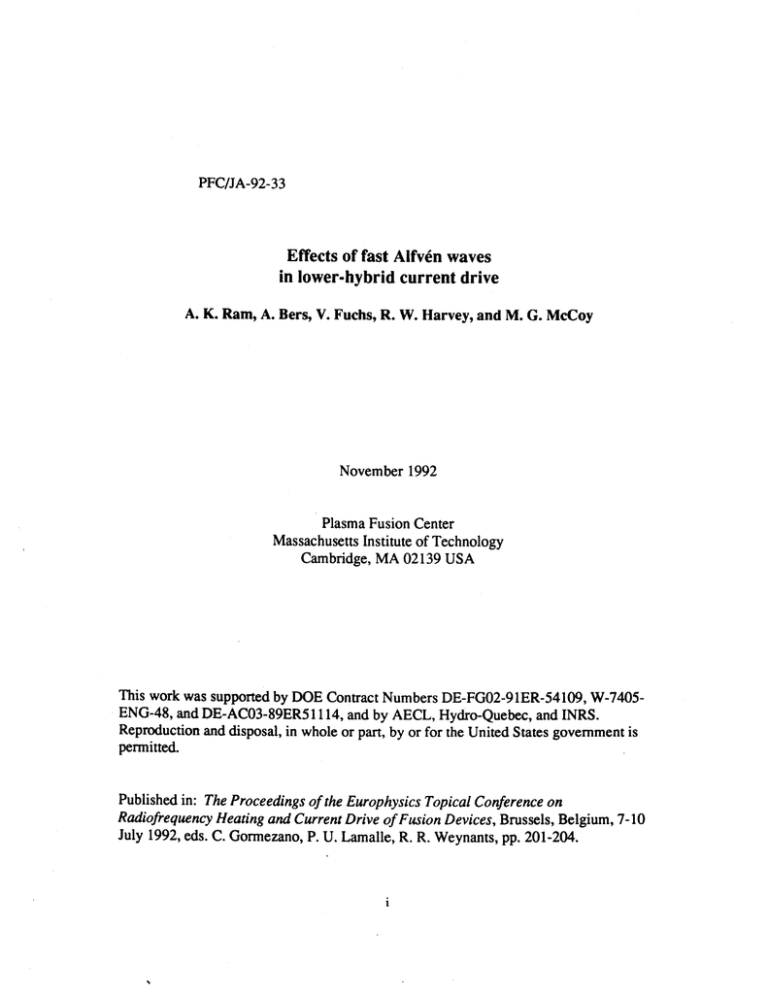
PFC/JA-92-33
Effects of fast Alfv6n waves
in lower-hybrid current drive
A. K. Ram, A. Bers, V. Fuchs, R. W. Harvey, and M. G. McCoy
November 1992
Plasma Fusion Center
Massachusetts Institute of Technology
Cambridge, MA 02139 USA
This work was supported by DOE Contract Numbers DE-FG02-91ER-54109, W-7405ENG-48, and DE-AC03-89ER51114, and by AECL, Hydro-Quebec, and INRS.
Reproduction and disposal, in whole or part, by or for the United States government is
permitted.
Published in: The Proceedingsof the Europhysics Topical Conference on
Radiofrequency Heating and CurrentDrive of Fusion Devices, Brussels, Belgium, 7-10
July 1992, eds. C. Gormezano, P. U. Lamalle, R. R. Weynants, pp. 201-204.
i
EFFECTS OF FAST ALFVEN WAVES
IN LOWER HYBRID CURRENT DRIVE
A. K. Ram, A. Bers, V. Fuchs, R. W. Harvey, and M. G. McCoy
Relativistic quasilinear diffusion coefficient
. . . . .
. . . . .
. . . . .
.
1
. . . . . . .
. . . . .
. . . . .
.
2
. . . . . . . . . . . . . . . . . .
. . . . .
.
4
LHCD in the presence of FAW/IBW
Table I
. . . . .
Acknowledgements . .
. . . .
. . . . . . . .
. . . . . .
. . . .
.
4
References . . . . .
. . . .
. . . . . . . .
. . . . . .
. . . .
.
4
ii
EFFECTS OF FAST ALFVEN WAVES IN LOWER HYBRID CURRENT DRIVE
A. K. Ram, A. Bers, V. Fuchs,* R. W. Harveyt and M. G. McCoy**
Plasma Fusion Center, M.I.T., Cambridge, Massachusetts, USA
The use of unidirectional lower hybrid (LH) waves to drive currents in plasmas
has been well-established in numerous experiments. Two new features of LH current
drive have emerged recently. The first, observed on JT-60 [1], was that the LH current
drive efficiency increased as the volume averaged electron temperature was increased.
The second, observed on JET [2], was that the current drive efficiency increased as
the LH waves were used in conjunction with fast Alfven waves (FAW). The increase in
the efficiency occurred at higher volume averaged electron temperatures while at low
temperatures the FAW did not seem to affect the LH current drive efficiency [2]. In
these experiments the FAW encountered a resonance/mode-conversion layer and part
of its energy flow could convert to ion-Bernstein waves (IBW). These must also be
considered in understanding the observed increase in current drive efficiency [3,4]. The
launched FAW spectrum was that of a monopole antenna so that the FAW/IBW by
themselves would not lead to any plasma current. In this paper we consider the possible
interactions of the FAW/IBW with the electron tail produced by the unidirectional LH
waves. This is done with a view towards understanding JET results and exploring
other synergistic current drive possibilities.
Relativistic quasilinear diffusion coefficient
For waves with frequencies, w, below the electron cyclotron frequency, the relativistic resonant diffusion equation is [5]:
-fo
= a
&
(1)
pi\D
p-f
where fo is the space-averaged and gyroangle-averaged distribution function, p11 is the
momentum along the ambient magnetic field Bo, and D is the quasilinear diffusion
coefficient.
Dr
=-2
f
d
kg
Do
D=V
e
(27r)3
(k1l -
(2)
(2)
where V is the appropriate volume of space over which the averaging takes place and
Do =
[iJ2IE,12+ JI02 Ekz
2
+ 2v' JoJlIm(E* E.)
(3)
*Centre Canadien de Fusion Magnetique, Varennes, Quebec, Canada, t General Atomics, San Diego, California, USA, **NERSC, Lawrence Livermore National Laboratory,
California, USA
1
Vi = p±/mY, vil = p 11/my, 72 = 1 + p 2 /m 2 c2 , and A1 is the Fourier transformed
electric field (z is along Bo). The argument of the Bessel functions is k±v±/fI. where
fl is the relativistic electron cyclotron frequency.
Do can be expressed in one of two convenient forms: Do = Do,IE, 12, and Do =
D0 2 |EhkM 12 where
Do,=
D02=
Jo-
-- JiIm E
|v
IVI
vII
I
)
vEk.J
VII
VII
2+
{
v-
JRe(
)}]
1~
2
JI+JOIM (E
Eiy
+ jJoRe
(
(4a)
Ek./
E
)2
1I
4b)
Eky(4
Do, and D0 2 are completely determined by the local dispersion relation for the appropriate rf wave. The amplitudes |E, 12 and IE, 12 are determined from the external
rf excitation structure and energy flow spectra into the plasma. For LH waves, (4a)
is appropriate, while for FAW (4b) is a suitable form. The term proportional to Jo
corresponds to electron Landau damping (ELD) while the term proportional to J1 corresponds to damping by transit time magnetic pumping (TTMP). For the FAW these
two effects oppose each other; for low v 1 's ELD dominates over TTMP while at higher
v I's TTMP becomes bigger than ELD.
lE W/E ,WI <
<
1, and assuming that IE H /Ef LI
1 for FAW, it is easy to see that:
Considering kvj/fl.
D$W
D02\
(v
<
1 for LH waves and
2
2
2kFW
0
(5)
Thus, for comparable energy flow densities, giving IEf 12
IlEkw 12, (5) indicates
that the FAW diffusion coefficient is small compared to the LH diffusion coefficient.
For mode converted ion-Bernstein waves (IBW) the appropriate form would be given
also by (4b). But as IBW's propagate away from the mode conversion layer their Ik I
(and IkL1) enhances significantly leading to electron Landau damping [6]. The dominant
contribution to the diffusion coefficient comes from the Jo term in (4b). Under JET-like
conditions, for example, D 0 2 for IBW's is about an order of magnitude smaller than
Do, for LHW's. The FAW D 0 2 is five to six orders of magnitude smaller. We thus must
conclude that in JET the FAW by itself can only affect the LHCD current drive by
heating the plasma-similar to what was observed in JT60 [1] (but where the plasma
heating was by neutral beam injection).
LHCD in the presence of FAW/IBW
The LHCD is relatively peaked off-axis [2],[7]. The small kII mode-converted spectrum of IBW's, if of sufficient amplitude, can act to extend the current drive spectrum
in the tail of the electron distribution function beyond the LHW spectrum. The IBW
spectrum that propagates further, upshifts to near thermal velocities and can also heat
the plasma. Similarly, the transmitted FAW power that returns to the resonance layer
is also mode-converted to IBW's and damps on electrons. Here we are only interested
in the interaction of the IBW's with electrons in the LHCD layer and assume that there
2
the IBW's are sufficiently intense. An analytic, nonrelativistic model developed just
for the LH waves [8] could then be used to roughly estimate the changes in current
drive efficiency. From this model we obtained:
V2(- v2)
Pd
(3Zi + 5)n(a3)- (Zi + 1)n(a)
(6)
where
am =
+ mT
a
=2
7 v2
v, + mTp
T.
a + 1)
- -
(v2a+1 -
(7a)
a+1
2(a - 1)(V2 - V1) -V1-
(v21
-V)
-
(V2~
a 2(1 + Zi)
2 + Zi
)
(7c)
Zi is the effective ion charge of the plasma, T, is the bulk electron temperature, vi
and v 2 are the lower and upper bounds, respectively, in parallel velocity (normalized
to thermal velocity (T,/m.)1/ 2 ) of the LH tail; j is the normalized current density and
pd is the normalized power dissipated [4,8]. The current drive efficiency is then given
by [4]:
77l= n20Rm
()(Ve
2
(8)
where nA is the Coulomb logarithm, and VTe = V/T 6 /m, is the electron thermal
velocity.
Assuming that the initital LH tail extends from vi = 4 to v 2 = 8 with Zi = 1,
then from (6) and (7): - = 26 and T, = 9.6; for T. = 1keV this gives 7 = 0.11 and
PdP
T 1 = 9.6keV. Now suppose that the FAW/IBM effectively extend this tail to v 2 = 12.
Then from (6) and (7) i = 48 and T, = 20; for T. = 1keV this gives: 7 = 0.2 and
TL = 20keV, while for T. = 2keV we obtain: 7 = 0.4 and TL = 40keV. Comparing
these we see that an extension of the original LH tail would lead to an increase in
the perpendicular temperature of the tail and an enhancement in the current drive
efficiency. If, in addition, the bulk electron temperature is increased, then the current
drive efficiency is enhanced by a larger factor compared to the case when the bulk
electron temperature remains unchanged. There is also a corresponding increase in the
tail perpendicular temperature.
A next step beyond this simple model is to go to a 2-D (momentum space) FokkerPlanck code including a quasilinear operator with the coefficient (4), assuming IEB 12
IELI,2 .
Using the code CQL3d [7] on one flux surface, we illustrate in Table I the effect
(at zero loop voltage) of the IBW under two different conditions. In row five only tail
electrons resonate with the IBW, in row six the IBW is allowed to penetrate to 3 VTe
which is somewhat below the LH spectrum lower bound at v, = 3 . 5 VT.. (In principle,
the IBW could go down to about 1.8vT, given enough kl-upshift.) The LH "base" case
is shown in row one. The main result, seen on comparison of rows one and six, is that
3
the current and current drive efficiency have gone up. We note that this synergism
occurs even though the IBW diffusion coefficient is about an order of magnitude below
the LH one for the same reference fields. Rows three and four indicate that we have
used unidirectional IBW spectra. For obvious reasons, this should be the preferred
configuration. For a symmetric IBW spectrum the IBW current from rows three and
four should be subtracted form the currents of, respectively, rows five and six. In
addition the IBW power dissipated is doubled. The net result for cases five and six is
that (I/P)is reduced, respectively, to 0.76 and 0.45.
Table I
Teo [keV]
vfH/VTe
VIBW/VTe
J[A/cm 2 ]
I/P[A/W] T±/Teo
LH
LH
IBW
IBW
4
7
7
7
3.5
3.5
-
-
3.5
3
280
81
10.5
79
0.73
0.87
0.57
0.5
8
3.6
1
2.5
LH+IBW
LH+IBW
7
7
3.5
3.5
3.5
3
91
304
1.04
0.88
3.8
4
Acknowledgements
This work was supported by DOE Contract Numbers DE-FG02-91ER-54109, W-
7405-ENG-48, and DE-AC03-89ER51114, and by AECL, Hydro-Quebec, and INRS.
References
[1] T. Imai and JT-60 Team, paper CN-53/E-1-3, IAEA, 13th Intern. Conf. Plasma
Phys. & Contr. Nucl. Fusion Res., Washington, D.C., 1-6 October, 1990.
[2] C. Gormezano, M. Brusati, A. Ekedahl, P. Froissard, J. Jaquinot, and F. Rimini,
in Proc. IAEA Tech. Comm. Mtg. on Fast Wave Current Drive in Reactor Scale
Tokamaks, Arles, France, 23-25 September 1991, Eds. D. Moreau, A. Becoulet,
and Y. Peysson, pp. 244-259.
[3] D. F. H. Start, et al., in Proc. IAEA Tech. Comm. Mtg. on Fast Wave Current
Drive in Reactor Scale Tokamaks, Arles, France, 23-25 September 1991, Eds. D.
Moreau, A. Becoulet, and Y. Peysson, pp. 226-242.
[4] A. Bers and A. K. Ram, in Proc. IAEA Tech. Comm. Mtg. on Fast Wave Current
Drive in Reactor Scale Tokamaks, Arles, France, 23-25 September 1991, Eds. D.
Moreau, A. Becoulet, and Y. Peysson, pp. 2-34.
[5] C. F. Kennel and F. Engelmann, Phys. Fluids 9, (1966) 2377; I. Lerche, Phys.
Fluids 11, (1968) 1720.
[6] A. K. Ram and A. Bers, Phys. Fluids B3, (1991) 1059.
[7] R. W. Harvey, M. G. McCoy, A. K. Ram, A. Bers, and V. Fuchs, this conference.
[8] V. Fuchs, R. A. Cairns, M. M. Shoucri, K. Hizanidis, and A. Bers, Phys. Fluids
28, (1985) 3619.
4

